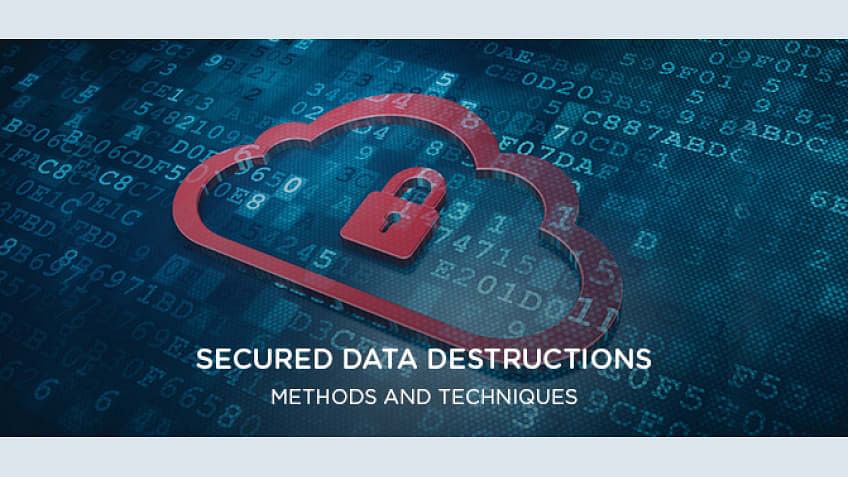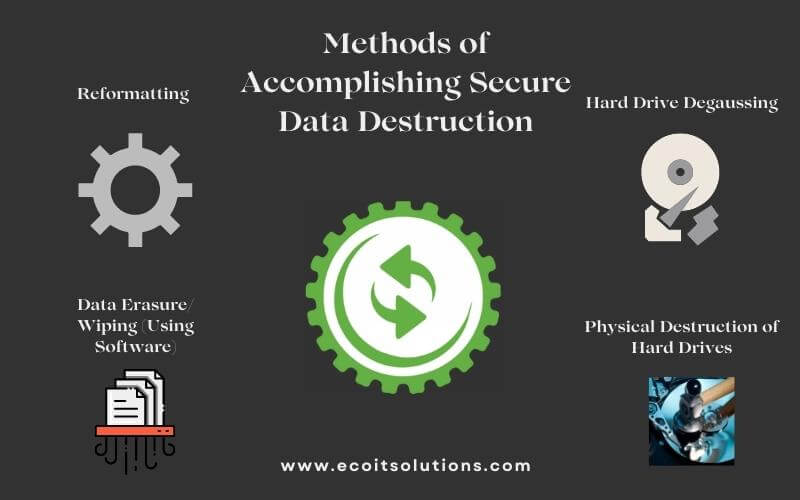Data Destruction Solutions: A Key Element in Your Cyber Security Approach
Data Destruction Solutions: A Key Element in Your Cyber Security Approach
Blog Article
Discovering the Importance of Data Devastation in the Context of Computer Security Solutions and Protecting Confidential Data
In a period where information breaches are increasingly typical, the value of effective information destruction can not be overemphasized. Organizations needs to embrace rigorous actions to guarantee that delicate information is not only protected throughout its lifecycle however additionally emphatically removed when no more needed. The methods used for information eradication, combined with compliance to lawful standards, play an essential function in keeping discretion and depend on. Nonetheless, the ramifications of these methods prolong past plain compliance, influencing a company's online reputation and operational integrity in the digital market. What strategies can organizations execute to improve their data devastation protocols?
Recognizing Information Damage
Information destruction is a critical element of computer system safety that involves the permanent removal of data from storage gadgets to prevent unauthorized access and potential data breaches. In an increasingly digital landscape, companies encounter heightened dangers related to sensitive information being incorrectly accessed or manipulated. Efficient information destruction safeguards versus these risks, making sure that confidential dataâEUR" such as customer info, intellectual home, and financial recordsâEUR" can not be recovered after disposal.
Comprehending the value of data destruction prolongs past mere conformity with regulatory and legal frameworks; it is necessary for maintaining organizational honesty and trust. When data is improperly taken care of or improperly destroyed, the effects can be severe, including financial loss, reputational damages, and legal liabilities.

Methods of Information Obliteration

One prevalent technique is data wiping, which entails overwriting existing information with arbitrary patterns multiple times. This method provides the original data irretrievable, making it a preferred selection for organizations seeking to shield secret information.
One more technique is degaussing, which utilizes a powerful magnetic area to disrupt the magnetic domain names on storage gadgets, efficiently eliminating the data. This technique is especially reliable for magnetic media but is not appropriate to solid-state drives.
Physical destruction is another robust method, entailing the shredding or crushing of storage tools. This approach assurances that data recuperation is basically difficult, making it excellent for very sensitive details.
Last but not least, encryption can work as a corresponding approach to data obliteration. By encrypting information prior to deletion, organizations can add an extra layer of safety, guaranteeing that even if residues are recouped, they stay unattainable without the decryption key. Each method must be selected based on the level of information sensitivity and the details safety and security requirements of the organization.
Legal Compliance and Data Security
Organizations should navigate a complex landscape of legal needs connected to data protection, specifically after carrying out approaches of data obliteration. Numerous guidelines, such as the General Information Security Regulation (GDPR) and the Medical Insurance Transportability and Accountability Act (HIPAA), enforce stringent standards on exactly how organizations need to get rid of and manage of delicate data. Failing to adhere to these laws can cause considerable lawful repercussions, consisting of significant fines and reputational damage.
Data damage procedures need to be diligently documented to show content conformity with applicable laws and standards. This documents not just works as proof of adherence to legal responsibilities however likewise illustrates a dedication to safeguarding sensitive details. Organizations must also develop clear plans regarding data retention and destruction timelines, making certain that data is not held longer than necessary.

In addition, normal audits and analyses of data damage practices are necessary to maintain conformity and adapt to progressing legal structures (data destruction). By proactively addressing lawful requirements, organizations can mitigate risks related to data breaches and demonstrate their dedication to information safety. Ultimately, prioritizing legal conformity in information devastation processes is not simply a regulative responsibility, however an essential facet of a robust data safety technique
Influence On Service Credibility
The online reputation of an organization can be substantially affected by its strategy to information devastation and management. In today's electronic landscape, where information breaches can happen anytime, the failure to effectively get rid of delicate details can bring about serious effects. Organizations that improperly handle data devastation danger exposing personal client information, which not just goes against privacy legislations yet also erodes trust fund among stakeholders and clients.
A damaged credibility can cause reduced customer commitment, as customers come to be hesitant to involve with an organization that has demonstrated carelessness in shielding their data. Additionally, unfavorable publicity bordering a data breach can have an enduring effect, as prospective consumers may be deterred by the viewed absence of security. This can bring about a straight decrease in income and market share.
Moreover, services that prioritize data devastation as component of their security technique can enhance their reputation by showcasing their commitment to securing delicate information. By taking on stringent data administration practices, organizations can not just reduce dangers however also place themselves as trustworthy entities in their respective sectors, therefore strengthening their overall brand name photo.

Ideal Practices for Secure Disposal
Implementing best methods for protected disposal of information is important for alleviating risks connected with information breaches and guaranteeing conformity with privacy regulations. Organizations must embrace a thorough information disposal plan that lays out treatments for both physical and electronic data devastation.
For physical data storage space tools, such as hard disks, shredding or degaussing is advised to protect against data recovery. Furthermore, organizations ought to preserve a chain of custody documents during the disposal process, making certain liability and traceability of disposed products.
For electronic data, utilizing software that follows market standards for information wiping is crucial. This software must overwrite existing information numerous times, making healing basically impossible. It is additionally vital to verify the efficiency of the data destruction read this post here procedure through audits or third-party assessments.
Training website link employees on protected disposal methods includes another layer of security, as human error can frequently result in data exposure. Consistently assessing and updating disposal plans makes certain placement with developing guidelines and technological developments. By applying these best practices, organizations can considerably decrease the danger of unauthorized data accessibility and improve their general data protection approach.
Final Thought
In final thought, data devastation is a basic element of computer system safety and security services that ensures the security of secret information from unauthorized accessibility. Carrying out efficient methods of data obliteration, adhering to legal compliance, and recognizing the influence on company track record are crucial parts of a comprehensive information safety and security approach. By embracing finest techniques for safe and secure disposal, organizations can cultivate trust fund with customers and secure sensitive data, ultimately contributing to an extra safe electronic landscape.
In an age where data breaches are significantly usual, the value of effective information destruction can not be overemphasized.Information devastation is a critical element of computer safety that includes the long-term removal of information from storage space tools to stop unapproved gain access to and possible information violations. Organizations needs to also establish clear policies pertaining to data retention and damage timelines, making sure that information is not held longer than essential.
By proactively dealing with legal demands, organizations can minimize threats linked with data violations and show their commitment to information security (data destruction). Inevitably, prioritizing lawful compliance in data devastation procedures is not simply a regulative responsibility, but a basic facet of a durable data security method
Report this page